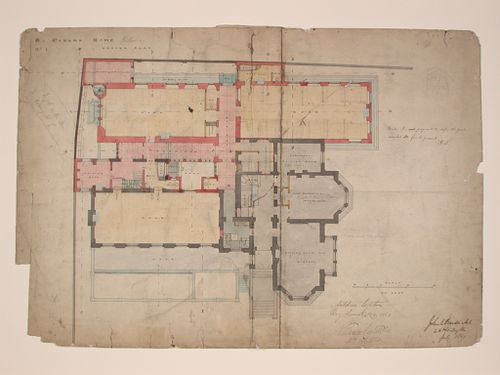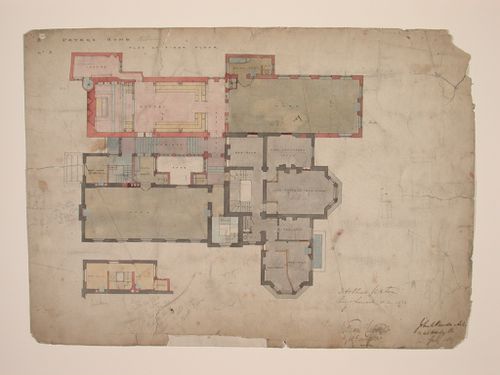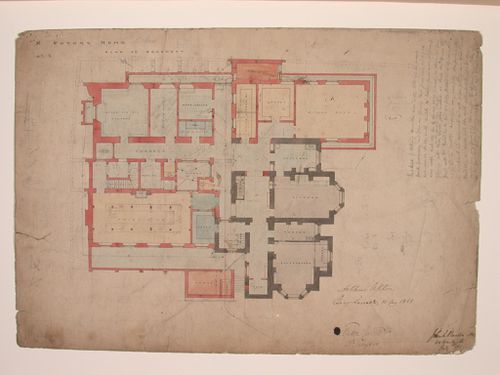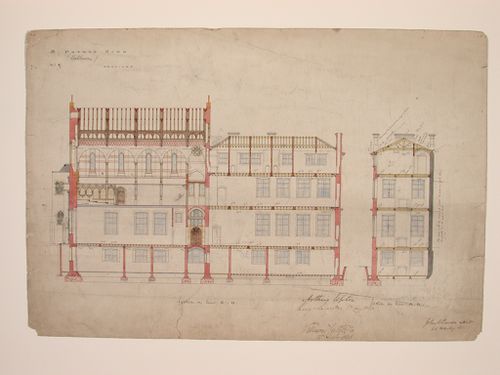DR1989:0015:008
Description:
- This drawing is part of an incomplete set of numbered contract drawings for St. Peter's Kilburn: DR1989:0015:001 - DR1989:0015:009. All nine drawings are done to the scale of 1¼" = 10, which figures on the ground plan, DR1989:0015:002, along with the section lines corresponding to the sections, DR1989:0015:005, DR1989:0015:007 - DR1989:0015:009. - This drawing is part of a group of drawings for St. Peter's Home, Kilburn, from the office of John Loughborough Pearson, composed of nine orthographic contract drawings dated 1867-1868 (DR1989:0015:001 - DR1989:0015:009) and one elevation for an addition in 1878 (DR1989:0015:010). These drawings were sold at auction by St. Peter's Convent, Woking, along with drawings for that institution (DR1989:0015:011 - DR1989:0015:089 R/V). Both institutions were commissioned from John Loughborough Pearson by Benjamin Lancaster. The alterations to the Home at Kilburn were commissioned on behalf of Lancaster's wife, who founded the home and the lay nursing order which ran it. Woking was founded by Lancaster as a home for incurables in 1882, and dedicated to the memory of his deceased wife (Quiney 67-68, 254-255, and 284). It was probably first known as St. Peter's Home, Woking, not becoming a convent until ca. 1934.
architecture
1867-1868
St. Peter's Home Kilburn: Cross-section and longitudinal section
Actions:
DR1989:0015:008
Description:
- This drawing is part of an incomplete set of numbered contract drawings for St. Peter's Kilburn: DR1989:0015:001 - DR1989:0015:009. All nine drawings are done to the scale of 1¼" = 10, which figures on the ground plan, DR1989:0015:002, along with the section lines corresponding to the sections, DR1989:0015:005, DR1989:0015:007 - DR1989:0015:009. - This drawing is part of a group of drawings for St. Peter's Home, Kilburn, from the office of John Loughborough Pearson, composed of nine orthographic contract drawings dated 1867-1868 (DR1989:0015:001 - DR1989:0015:009) and one elevation for an addition in 1878 (DR1989:0015:010). These drawings were sold at auction by St. Peter's Convent, Woking, along with drawings for that institution (DR1989:0015:011 - DR1989:0015:089 R/V). Both institutions were commissioned from John Loughborough Pearson by Benjamin Lancaster. The alterations to the Home at Kilburn were commissioned on behalf of Lancaster's wife, who founded the home and the lay nursing order which ran it. Woking was founded by Lancaster as a home for incurables in 1882, and dedicated to the memory of his deceased wife (Quiney 67-68, 254-255, and 284). It was probably first known as St. Peter's Home, Woking, not becoming a convent until ca. 1934.
architecture
DR1989:0015:009
Description:
- This drawing is part of an incomplete set of numbered contract drawings for St. Peter's Kilburn: DR1989:0015:001 - DR1989:0015:009. All nine drawings are done to the scale of 1¼" = 10', which figures on the ground plan, DR1989:0015:002, along with the section lines corresponding to the sections DR1989:0015:005, DR1989:0015:007 - DR1989:0015:009. - This drawing is part of a group of drawings for St. Peter's Home, Kilburn, from the office of John Loughborough Pearson, composed of nine orthographic contract drawings dated 1867-1868 (DR1989:0015:001 - DR1989:0015:009) and one elevation for an addition in 1878 (DR1989:0015:010). These drawings were sold at auction by St. Peter's Convent, Woking, along with drawings for that institution (DR1989:0015:011 - DR1989:0015:089 R/V). Both institutions were commissioned from John Loughborough Pearson by Benjamin Lancaster. The alterations to the Home at Kilburn were commissioned on behalf of Lancaster's wife, who founded the home and the lay nursing order which ran it. Woking was founded by Lancaster as a home for incurables in 1882, and dedicated to the memory of his deceased wife (Quiney 67-68, 254-255, and 284). It was probably first known as St. Peter's Home, Woking, not becoming a convent until ca. 1934.
architecture
1867-1868
St. Peter's Home, Kilburn: Longitudinal section and details
Actions:
DR1989:0015:009
Description:
- This drawing is part of an incomplete set of numbered contract drawings for St. Peter's Kilburn: DR1989:0015:001 - DR1989:0015:009. All nine drawings are done to the scale of 1¼" = 10', which figures on the ground plan, DR1989:0015:002, along with the section lines corresponding to the sections DR1989:0015:005, DR1989:0015:007 - DR1989:0015:009. - This drawing is part of a group of drawings for St. Peter's Home, Kilburn, from the office of John Loughborough Pearson, composed of nine orthographic contract drawings dated 1867-1868 (DR1989:0015:001 - DR1989:0015:009) and one elevation for an addition in 1878 (DR1989:0015:010). These drawings were sold at auction by St. Peter's Convent, Woking, along with drawings for that institution (DR1989:0015:011 - DR1989:0015:089 R/V). Both institutions were commissioned from John Loughborough Pearson by Benjamin Lancaster. The alterations to the Home at Kilburn were commissioned on behalf of Lancaster's wife, who founded the home and the lay nursing order which ran it. Woking was founded by Lancaster as a home for incurables in 1882, and dedicated to the memory of his deceased wife (Quiney 67-68, 254-255, and 284). It was probably first known as St. Peter's Home, Woking, not becoming a convent until ca. 1934.
architecture
drawings
DR1988:0433:010
Description:
- Abrasion marks at the t. indicate that the finial on the tallest turret of the great tower was erased. - One of a group of working drawings for William Burn's October 1849 project for Fonthill House, Wiltshire, a country house designed in the Jacobethan style. This group represents only one of the projects that Burn proposed for Fonthill House; the final project, executed in 1856, was much smaller (Walker, 31, illustrated in Hitchcock, vol. 2, fig. VIII 31). Drawings include plans, elevations, and sections, as well as full-scale drawings of masonry details. Approximately half of the drawings are part of a numbered series from one to twenty-two, while the other drawings, mostly masonry details, were not numbered. These latter drawings are not as carefully finished, and a few are incomplete.
architecture
October 1849
East elevation for Fonthill House, with section on line IK
Actions:
DR1988:0433:010
Description:
- Abrasion marks at the t. indicate that the finial on the tallest turret of the great tower was erased. - One of a group of working drawings for William Burn's October 1849 project for Fonthill House, Wiltshire, a country house designed in the Jacobethan style. This group represents only one of the projects that Burn proposed for Fonthill House; the final project, executed in 1856, was much smaller (Walker, 31, illustrated in Hitchcock, vol. 2, fig. VIII 31). Drawings include plans, elevations, and sections, as well as full-scale drawings of masonry details. Approximately half of the drawings are part of a numbered series from one to twenty-two, while the other drawings, mostly masonry details, were not numbered. These latter drawings are not as carefully finished, and a few are incomplete.
drawings
October 1849
architecture
drawings
DR1988:0433:011
Description:
- Abrasion marks at the t. indicated that the finial on the tallest turret of the great tower was erased. - One of a group of working drawings for William Burn's October 1849 project for Fonthill House, Wiltshire, a country house designed in the Jacobethan style. This group represents only one of the projects that Burn proposed for Fonthill House; the final project, executed in 1856, was much smaller (Walker, 31, illustrated in Hitchcock, vol. 2, fig. VIII 31). Drawings include plans, elevations, and sections, as well as full-scale drawings of masonry details. Approximately half of the drawings are part of a numbered series from one to twenty-two, while the other drawings, mostly masonry details, were not numbered. These latter drawings are not as carefully finished, and a few are incomplete.
architecture
October 1849
South elevation for Fonthill House
Actions:
DR1988:0433:011
Description:
- Abrasion marks at the t. indicated that the finial on the tallest turret of the great tower was erased. - One of a group of working drawings for William Burn's October 1849 project for Fonthill House, Wiltshire, a country house designed in the Jacobethan style. This group represents only one of the projects that Burn proposed for Fonthill House; the final project, executed in 1856, was much smaller (Walker, 31, illustrated in Hitchcock, vol. 2, fig. VIII 31). Drawings include plans, elevations, and sections, as well as full-scale drawings of masonry details. Approximately half of the drawings are part of a numbered series from one to twenty-two, while the other drawings, mostly masonry details, were not numbered. These latter drawings are not as carefully finished, and a few are incomplete.
drawings
October 1849
architecture
drawings
DR1988:0433:012
Description:
- Abrasion marks at the t. indicate that the finial on the tallest turret of the great tower was erased. - One of a group of working drawings for William Burn's October 1849 project for Fonthill House, Wiltshire, a country house designed in the Jacobethan style. This group represents only one of the projects that Burn proposed for Fonthill House; the final project, executed in 1856, was much smaller (Walker, 31, illustrated in Hitchcock, vol. 2, fig. VIII 31). Drawings include plans, elevations, and sections, as well as full-scale drawings of masonry details. Approximately half of the drawings are part of a numbered series from one to twenty-two, while the other drawings, mostly masonry details, were not numbered. These latter drawings are not as carefully finished, and a few are incomplete.
architecture
October 1849
West elevation for Fonthill House
Actions:
DR1988:0433:012
Description:
- Abrasion marks at the t. indicate that the finial on the tallest turret of the great tower was erased. - One of a group of working drawings for William Burn's October 1849 project for Fonthill House, Wiltshire, a country house designed in the Jacobethan style. This group represents only one of the projects that Burn proposed for Fonthill House; the final project, executed in 1856, was much smaller (Walker, 31, illustrated in Hitchcock, vol. 2, fig. VIII 31). Drawings include plans, elevations, and sections, as well as full-scale drawings of masonry details. Approximately half of the drawings are part of a numbered series from one to twenty-two, while the other drawings, mostly masonry details, were not numbered. These latter drawings are not as carefully finished, and a few are incomplete.
drawings
October 1849
architecture
DR1989:0015:001
Description:
- This drawing is part of an incomplete set of numbered contract drawings for St. Peter's Home, Kilburn: DR1989:0015:001 - DR1989:0015:009. All nine drawings are done to the scale of 1¼" = 10', which figures on the ground plan, DR1989:0015:002, along with the section lines corresponding to sections DR1989:0015:005, DR1988:0015:007 - DR1989:0015:009. - This drawing is part of a group of drawings for St. Peter's Home, Kilburn, from the office of John Loughborough Pearson, composed of nine orthographic contract drawings dated 1867-1868 (DR1989:0015:001 - DR1989:0015:009) and one elevation for an addition in 1878 (DR1989:0015:010). These drawings were sold at auction by St. Peter's Convent, Woking, along with drawings for that institution (DR1989:0015:011 - DR1989:0015:089 R/V). Both institutions were commissioned from John Loughborough Pearson by Benjamin Lancaster. The alterations to the Home at Kilburn were commissioned on behalf of Lancaster's wife, who founded the home and the lay nursing order which ran it. Woking was founded by Lancaster as a home for incurables in 1882, and dedicated to the memory of his deceased wife (Quiney 67-68, 254-255, and 284). It was probably first known as St. Peter's Home, Woking, not becoming a convent until ca. 1934.
architecture
1867-1868
St. Peter's Home, Kilburn: Basement plan
Actions:
DR1989:0015:001
Description:
- This drawing is part of an incomplete set of numbered contract drawings for St. Peter's Home, Kilburn: DR1989:0015:001 - DR1989:0015:009. All nine drawings are done to the scale of 1¼" = 10', which figures on the ground plan, DR1989:0015:002, along with the section lines corresponding to sections DR1989:0015:005, DR1988:0015:007 - DR1989:0015:009. - This drawing is part of a group of drawings for St. Peter's Home, Kilburn, from the office of John Loughborough Pearson, composed of nine orthographic contract drawings dated 1867-1868 (DR1989:0015:001 - DR1989:0015:009) and one elevation for an addition in 1878 (DR1989:0015:010). These drawings were sold at auction by St. Peter's Convent, Woking, along with drawings for that institution (DR1989:0015:011 - DR1989:0015:089 R/V). Both institutions were commissioned from John Loughborough Pearson by Benjamin Lancaster. The alterations to the Home at Kilburn were commissioned on behalf of Lancaster's wife, who founded the home and the lay nursing order which ran it. Woking was founded by Lancaster as a home for incurables in 1882, and dedicated to the memory of his deceased wife (Quiney 67-68, 254-255, and 284). It was probably first known as St. Peter's Home, Woking, not becoming a convent until ca. 1934.
architecture
DR1989:0015:004
Description:
- This drawing is part of an incomplete set of numbered contract drawings for St. Peter's Home, Kilburn: DR1989:0015:001 - DR1989:0015:009. All nine drawings are done to the scale of 1¼" = 10', which figures on the ground plan, DR1989:0015:002, along with the section lines corresponding to sections DR1989:0015:005, DR1989:0015:007 - DR1989:0015:009. - This drawing is part of a group of drawings for St. Peter's Home, Kilburn, from the office of John Loughborough Pearson, composed of nine orthographic contract drawings dated 1867-1868 (DR1989:0015:001 - DR1989:0015:009) and one elevation for an addition in 1878 (DR1989:0015:010). These drawings were sold at auction by St. Peter's Convent, Woking, along with drawings for that institution (DR1989:0015:011 - DR1989:0015:089 R/V). Both institutions were commissioned from John Loughborough Pearson by Benjamin Lancaster. The alterations to the Home at Kilburn were commissioned on behalf of Lancaster's wife, who founded the home and the lay nursing order which ran it. Woking was founded by Lancaster as a home for incurables in 1882, and dedicated to the memory of his deceased wife (Quiney 67-68, 254-255, and 284). It was probably first known as St. Peter's Home, Woking, not becoming a convent until ca. 1934.
architecture
1867-1868
St. Peter's Home, Kilburn: Second floor plan
Actions:
DR1989:0015:004
Description:
- This drawing is part of an incomplete set of numbered contract drawings for St. Peter's Home, Kilburn: DR1989:0015:001 - DR1989:0015:009. All nine drawings are done to the scale of 1¼" = 10', which figures on the ground plan, DR1989:0015:002, along with the section lines corresponding to sections DR1989:0015:005, DR1989:0015:007 - DR1989:0015:009. - This drawing is part of a group of drawings for St. Peter's Home, Kilburn, from the office of John Loughborough Pearson, composed of nine orthographic contract drawings dated 1867-1868 (DR1989:0015:001 - DR1989:0015:009) and one elevation for an addition in 1878 (DR1989:0015:010). These drawings were sold at auction by St. Peter's Convent, Woking, along with drawings for that institution (DR1989:0015:011 - DR1989:0015:089 R/V). Both institutions were commissioned from John Loughborough Pearson by Benjamin Lancaster. The alterations to the Home at Kilburn were commissioned on behalf of Lancaster's wife, who founded the home and the lay nursing order which ran it. Woking was founded by Lancaster as a home for incurables in 1882, and dedicated to the memory of his deceased wife (Quiney 67-68, 254-255, and 284). It was probably first known as St. Peter's Home, Woking, not becoming a convent until ca. 1934.
architecture
Project
AP206.S1.1960.PR01
Description:
This project series documents the Tagore Theatre in Sector 18 in Chandigarh, India from 1960-1962. This project consisted of a 600-seat theatre comprised of two square-shaped volumes, turned on their axis to overlap at their corners. The stage was located directly at the overlap, with the back-of-house occupying one square and the audience in the other. Inside, the roof frame was left exposed and meticulous detail was paid to the theatre's acoustics. The building's brick exterior had almost no windows, except those located along the first-level below a canopy that wrapped the theatre. Large-scale alterations have since been made to the iconic theatre. The project is recorded through drawings and textual records dating from 1949-2001. The majority of the drawings are reprographic copies, but many are annotated. There are a number of drawings dating from 1999-2001 that likely show future work to the theatre, since they are outside the scope of the theatre's original construction. The textual records consist of research on theatre design, dating much earlier than this project, and a magazine review of the acoustics in the Tagore Theatre.
1949-2001
Tagore Theatre, Chandigarh, India (1960-1962)
Actions:
AP206.S1.1960.PR01
Description:
This project series documents the Tagore Theatre in Sector 18 in Chandigarh, India from 1960-1962. This project consisted of a 600-seat theatre comprised of two square-shaped volumes, turned on their axis to overlap at their corners. The stage was located directly at the overlap, with the back-of-house occupying one square and the audience in the other. Inside, the roof frame was left exposed and meticulous detail was paid to the theatre's acoustics. The building's brick exterior had almost no windows, except those located along the first-level below a canopy that wrapped the theatre. Large-scale alterations have since been made to the iconic theatre. The project is recorded through drawings and textual records dating from 1949-2001. The majority of the drawings are reprographic copies, but many are annotated. There are a number of drawings dating from 1999-2001 that likely show future work to the theatre, since they are outside the scope of the theatre's original construction. The textual records consist of research on theatre design, dating much earlier than this project, and a magazine review of the acoustics in the Tagore Theatre.
Project
1949-2001
drawings
DR1989:0015:013
Description:
- This incomplete set of numbered contract drawings, DR1989:0015:012 - DR1989:0015:016, have the same scale, colour-coding, title format and script. With the exception of the ground plan DR1989:0015:012, which was probably cut down, the sheets are of similar dimensions and are signed by the architect in the l.r. corner. DR1989:0015:012 - DR1989:0015:016 are keyed to the ground plan, DR1989:0015:012. - This work is part of a group of drawings and reprographic prints of drawings for St. Peter's Home, Woking, and St. Peter's Convent, Woking, from the offices of John Loughborough Pearson and Frank Loughborough Pearson (DR1989:0015:011 - DR1989:0015:085 R/V). Composed of contract and working drawings including plans, site plans, sections, and elevations dated between 1881 and 1936, these drawings were sold at auction by the convent along with those for the older institution of St. Peter's Home, Kilburn (DR1989:0015:001 - DR1989:0015:010). Both St. Peter's Home, Kilburn, and St. Peter's Home, Woking were commissioned from John Loughborough Pearson by Benjamin Lancaster. The alterations to the Home at Kilburn were commissioned on behalf of Lancaster's wife, who founded the home and a lay nursing order which ran it. The institution at Woking was founded by Lancaster as a home for incurables in 1882 and dedicated to the memory of his deceased wife (Quiney 67-68, 254-255, and 284). It was probably first known as St. Peter's Home, Woking, not becoming a convent until ca. 1934.
architecture
1882 ?
St. Peter's Home, Woking: First floor plan
Actions:
DR1989:0015:013
Description:
- This incomplete set of numbered contract drawings, DR1989:0015:012 - DR1989:0015:016, have the same scale, colour-coding, title format and script. With the exception of the ground plan DR1989:0015:012, which was probably cut down, the sheets are of similar dimensions and are signed by the architect in the l.r. corner. DR1989:0015:012 - DR1989:0015:016 are keyed to the ground plan, DR1989:0015:012. - This work is part of a group of drawings and reprographic prints of drawings for St. Peter's Home, Woking, and St. Peter's Convent, Woking, from the offices of John Loughborough Pearson and Frank Loughborough Pearson (DR1989:0015:011 - DR1989:0015:085 R/V). Composed of contract and working drawings including plans, site plans, sections, and elevations dated between 1881 and 1936, these drawings were sold at auction by the convent along with those for the older institution of St. Peter's Home, Kilburn (DR1989:0015:001 - DR1989:0015:010). Both St. Peter's Home, Kilburn, and St. Peter's Home, Woking were commissioned from John Loughborough Pearson by Benjamin Lancaster. The alterations to the Home at Kilburn were commissioned on behalf of Lancaster's wife, who founded the home and a lay nursing order which ran it. The institution at Woking was founded by Lancaster as a home for incurables in 1882 and dedicated to the memory of his deceased wife (Quiney 67-68, 254-255, and 284). It was probably first known as St. Peter's Home, Woking, not becoming a convent until ca. 1934.
drawings
1882 ?
architecture
drawings
DR1989:0015:014
Description:
- This incomplete set of numbered contract drawings, DR1989:0015:012 - DR1989:0015:016, have the same scale, colour-coding, title format and script. With the exception of the ground plan DR1989:0015:012, which was probably cut down, the sheets are of similar dimensions and are signed by the architect in the l.r. corner. DR1989:0015:012 - DR1989:0015:016 are keyed to the ground plan, DR1989:0015:012. - This work is part of a group of drawings and reprographic prints of drawings for St. Peter's Home, Woking, and St. Peter's Convent, Woking, from the offices of John Loughborough Pearson and Frank Loughborough Pearson (DR1989:0015:011 - DR1989:0015:085 R/V). Composed of contract and working drawings including plans, site plans, sections, and elevations dated between 1881 and 1936, these drawings were sold at auction by the convent along with those for the older institution of St. Peter's Home, Kilburn (DR1989:0015:001 - DR1989:0015:010). Both St. Peter's Home, Kilburn, and St. Peter's Home, Woking were commissioned from John Loughborough Pearson by Benjamin Lancaster. The alterations to the Home at Kilburn were commissioned on behalf of Lancaster's wife, who founded the home and a lay nursing order which ran it. The institution at Woking was founded by Lancaster as a home for incurables in 1882 and dedicated to the memory of his deceased wife (Quiney 67-68, 254-255, and 284). It was probably first known as St. Peter's Home, Woking, not becoming a convent until ca. 1934.
architecture
1882 ?
St. Peter's Home, Woking: West elevation
Actions:
DR1989:0015:014
Description:
- This incomplete set of numbered contract drawings, DR1989:0015:012 - DR1989:0015:016, have the same scale, colour-coding, title format and script. With the exception of the ground plan DR1989:0015:012, which was probably cut down, the sheets are of similar dimensions and are signed by the architect in the l.r. corner. DR1989:0015:012 - DR1989:0015:016 are keyed to the ground plan, DR1989:0015:012. - This work is part of a group of drawings and reprographic prints of drawings for St. Peter's Home, Woking, and St. Peter's Convent, Woking, from the offices of John Loughborough Pearson and Frank Loughborough Pearson (DR1989:0015:011 - DR1989:0015:085 R/V). Composed of contract and working drawings including plans, site plans, sections, and elevations dated between 1881 and 1936, these drawings were sold at auction by the convent along with those for the older institution of St. Peter's Home, Kilburn (DR1989:0015:001 - DR1989:0015:010). Both St. Peter's Home, Kilburn, and St. Peter's Home, Woking were commissioned from John Loughborough Pearson by Benjamin Lancaster. The alterations to the Home at Kilburn were commissioned on behalf of Lancaster's wife, who founded the home and a lay nursing order which ran it. The institution at Woking was founded by Lancaster as a home for incurables in 1882 and dedicated to the memory of his deceased wife (Quiney 67-68, 254-255, and 284). It was probably first known as St. Peter's Home, Woking, not becoming a convent until ca. 1934.
drawings
1882 ?
architecture



